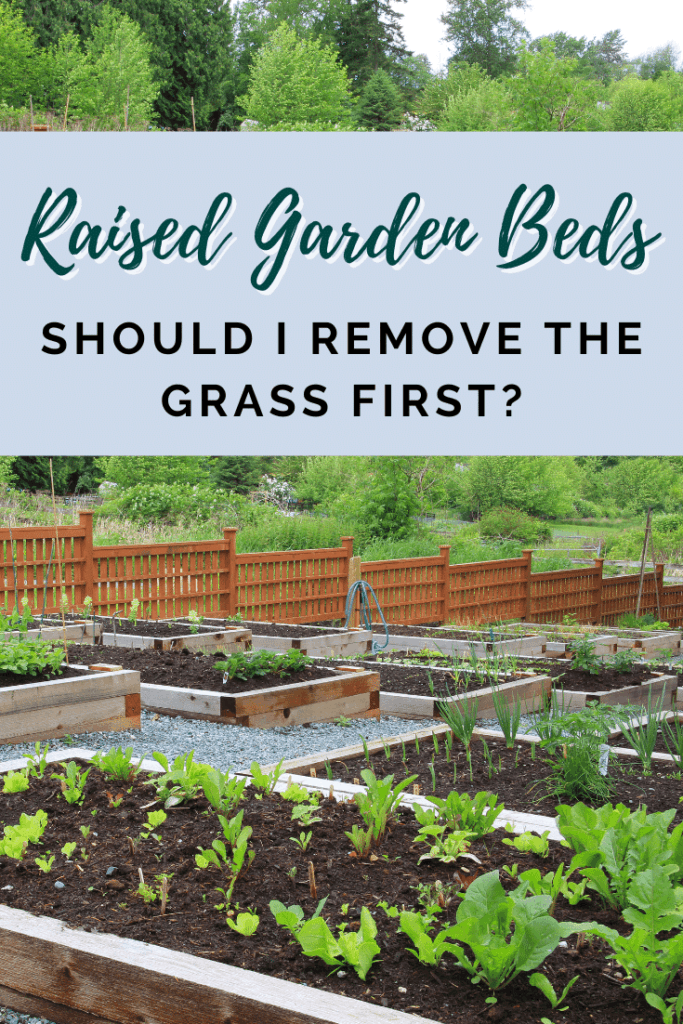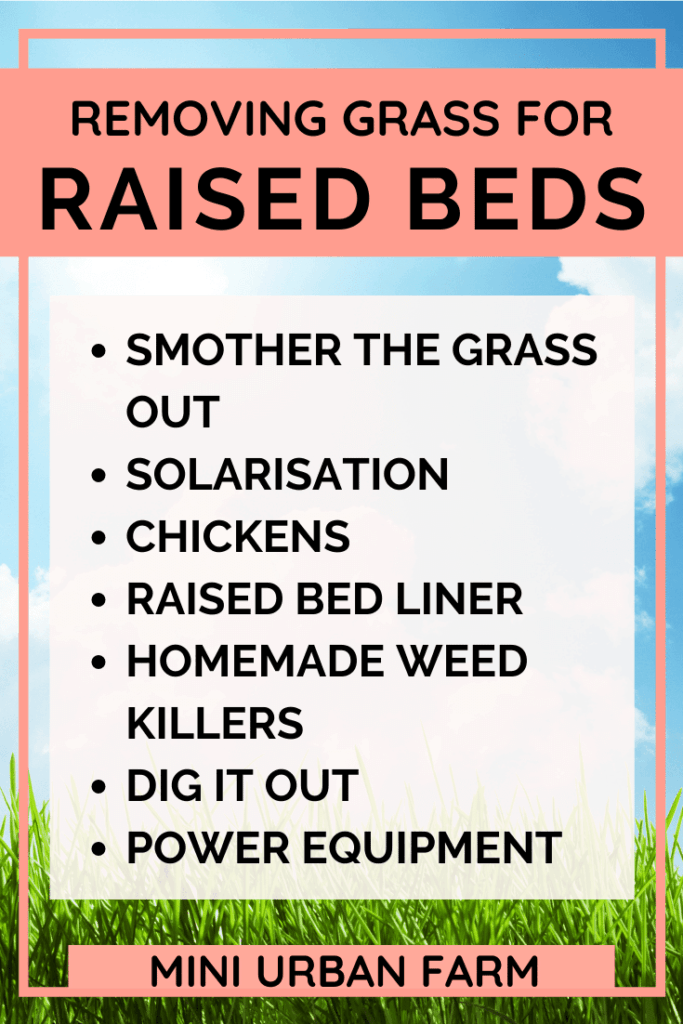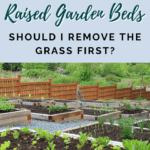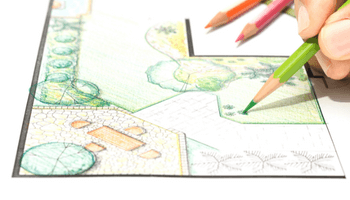The other evening, I was scrolling through my news feed and I saw that someone posted a question about removing grass under a raised bed. Apparently she had some concern about setting up her raised beds on top of her existing lawn – in fear of the grass growing through the soil and killing her plants. So her question was, do you need to remove grass under a raised garden bed.
No, there is no need to remove grass under a raised garden bed as long as the bed is filled with enough soil to smother out the grass. To kill the grass completely it requires a rich amount of soil which gives the grass no breathing space and no sunlight. Eventually it will die out, roots, pathogens, and everything else.
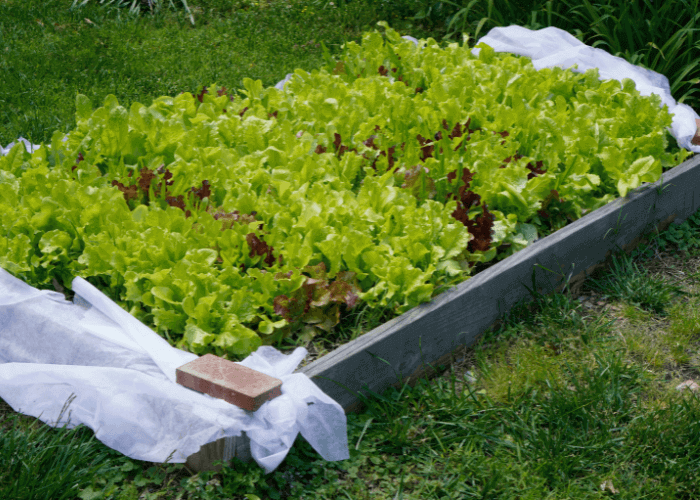
Disclosure: This post may contain affiliate links. If you purchase a product through one of our affiliate links we make a small commission from the sale at no extra cost to our readers.
Ways to Build a Raised Bed on Top of Grass
You can build a raised garden bed on top of grass.
To do this you need to make sure that the grass does not grow through the topsoil, compost, or whatever your raised beds are being filled with.
This can be done by first mowing the area that you are going to place your raised bed as close to the ground as possible and also clear it from all the weed.
Once that is done, newspapers or cardboard can be used to make the base of your raised bed.
Then 6-12 12 inches of soil should be placed inside of the raised bed. This would prevent the grass from growing over the topsoil and will suffocate it completely.
Not only will the grass die using this method, but all of the 4-6 inch grass roots and pathogens in the soil will die as well.
If you are looking to have a shallow raised garden bed then it would be best to remove all the grass completely to prevent it from growing into your bed.
However, there are several other ways to remove grass in order to build a raised bed.
Removing the Grass
If you still aren’t convinced that the above method is for you, or if you’re planning on building a very shallow raised bed, then there are several other techniques that are very effective for removing grass.
Let’s look at the pros and cons of each one!
Solarisation
Solarisation is a technique in which you cover the grass with plastic.
This uses a combination of the greenhouse effect and solar energy to kill the grass. It can be very effective since it destroys everything under the plastic by essentially burning it out.
Simply use a huge tarp or plastic sheet to cover the grass you want to remove. Hold it in place with heavy bricks or rocks to make sure the entire area is not exposed to the sun.
The initial cost for using this method would only be the cost of the plastic tarp and bricks – so it is fairly cost effective if you’re trying to garden on a budget.
However, if you are in a rush for time, this method is not for you. Using this method could potentially take months to see any results.
Of course, the more sunlight you have, the more effective it will be and the faster this technique will work.
Psst…want to fast track your garden? Get access to my FREE gardening resource library and start maximizing your garden today!
Chickens
Using chickens as a way to remove grass is not something most people consider.
But hear me out.
Chickens are highly destructive – this is why most gardeners try as hard as possible to keep chickens away from their garden.
This being said, chickens do have a place in the gardening world – they are amazing at preparing garden beds!
Allow your chickens to free range in your yard for several weeks – or even months – and all the grass will be gone – along with all the grass roots and weeds!
Plus, in the process of eating and destroying the grass, they drop rich fertilizer in the form of chicken manure!
Relocate your chickens to a safer part of the garden once you see that the grass is all gone!
This is probably the easiest way to remove grass – with the only con being that you need to get some chickens!
And if you need some help getting started, check out these chicken keeping posts!
Raised Garden Bed Liner
You can use a raised garden bed liner made of plastic to prevent the grass from growing into the raised bed.
However, there are some drawbacks to keep in mind before considering this technique.
Using plastic raised bed liners can reduce the drainage of your raised garden bed, keeping water at the base of your roots and causing root rot.
Therefore, you would need to drill some holes in the plastic lining to allow for drainage, but this would open up the risk of the grass coming through again.
If you’re willing to take your chances on that, then this might be a good method for you.
Homemade Weed Killer
Using weed killers can be dangerous to the vegetables or herbs in your garden, as I’m sure you already know.
A safer alternative would be to use homemade weed killers. These include saltwater, vinegar, or boiling water, sprayed directly onto the grass.
These methods might be the cheapest solutions, but might also take several tries to get it right.
Dig it out
The title says it all – a simple method to remove the grass is by simply digging it out.
This would require a shovel, a wheelbarrow, stakes and some twine or rope. A pitchfork can also be helpful for this task.
You can also use a sod removal tool to help. It makes it a tad bit easier than just using a shovel!
The first task should be to know the area you are going to build your raised bed. Keep track of any irrigation, electrical lines, or other items under the soil that can be an issue!
You can mark your raised bed out using the rope and the stakes once you’ve determined where they will go.
Then, begin digging and make sure you get all the roots too!
This method is probably my least favorite since it requires the most amount of effort and time!
Plus it leaves you sore for a few days after, and leaves a mess in the garden!
Power equipment
You can use power equipment to get rid of the grass. This saves a lot of time and avoids tons of manual labor.
Choose from two types of tools – a turf cutter or a tiller.
A turf cutter removes the grass from the roots with the soil still attached. This removes the grass in a very neat manner hence making them reusable.
The tiller can be either powered through gas or electric. It removes the grass from the roots.
If you use this method, you will not be able to plant the grass again. You can toss it into the compost pile. This way you can use the nutrients present in the soil for your garden next year.
This method definitely requires less effort and time, but can be very costly if you need to rent the tools.
However, it would be much faster than many of the methods above. And would allow you to start your beds right away!
What can be used in the base for raised garden beds?
Fill your raised garden beds with organic matter as well as a raised bed soil mix. A good raised bed soil mix consists of peat moss, compost, top soil, and perlite. This will allow for drainage in the raised beds, while still keeping valuable nutrients in the soil. Over time, you will need to refill the beds, as the soil breaks down and compacts.
Is it safe to use Concrete Blocks for Raised Beds?
According to the research conducted by Oregon State University, lime formation occurs in the soil due to concrete blocks over some time. Lime is not harmful to us but it can cause a surge in the acidity of the soil of the raised bed. So yes, it is safe to use concrete blocks for raised beds. But make sure to keep a check on the pH level of your soil so that your plants do not become negatively affected.
What are a few things to keep in mind while preparing a raised bed for the winter?
My first advice as an experienced gardener would be to add a layer of mulch and compost. Clear the raised garden bed of any weeds and add at least 1-2 inches of good quality finished compost. Use 1-2 inches of mulch to prevent any weeds from growing through. Mulching also provides insulation to the bed in the cold weather, helping to keep the soil draining properly.
At the end of the day, every gardener has to determine which gardening techniques are right for their own situation. Hopefully, the information provided in this article will help you decide which techniques are best for you. And if you should be removing the grass under your raised beds. One thing about gardening is that the more you do it the more experience you gain. So it’s never hurtful to try different methods and see which one works the best!
I hope this was super helpful! And for more gardening resources, get access to our free gardening resource library! It will help you fast track your garden and it only takes 5 seconds!
Pin Do You Need to Remove Grass Under a Raised Garden Bed?
